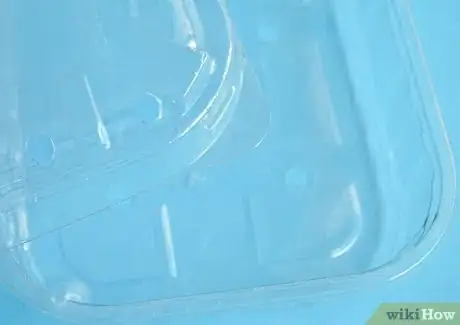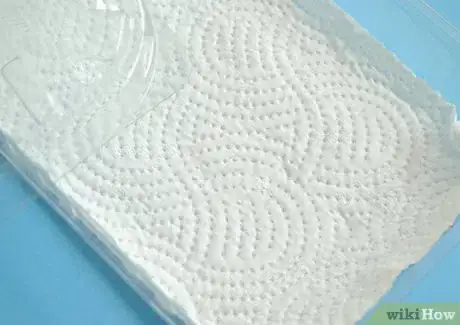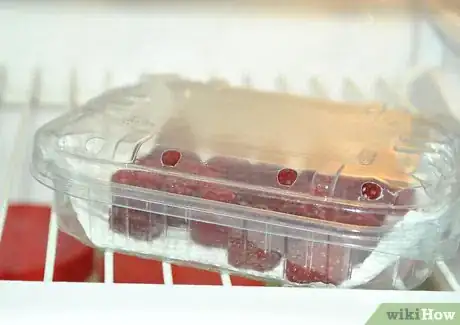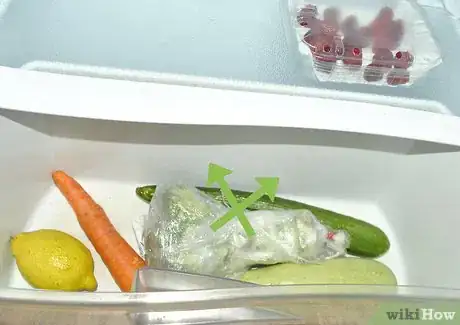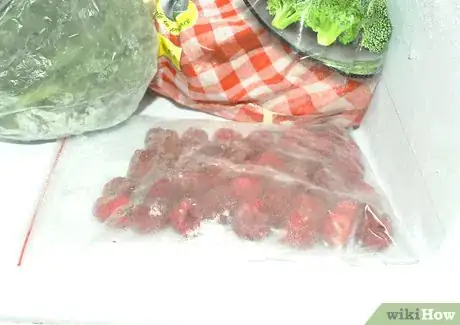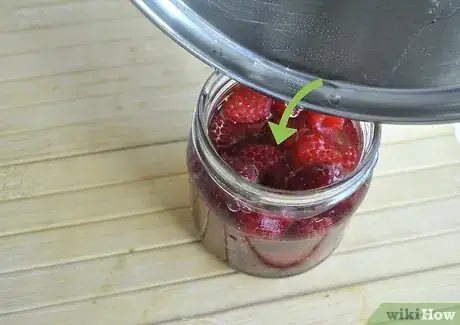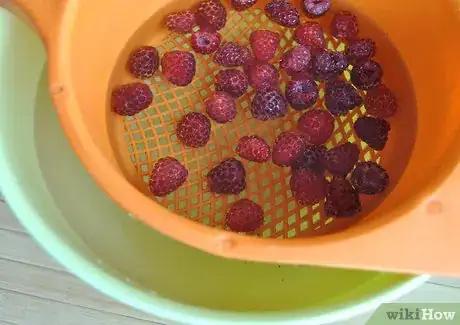This article was co-authored by Ollie George Cigliano. Ollie George Cigliano is a Private Chef, Food Educator, and Owner of Ollie George Cooks, based in Long Beach, California. With over 20 years of experience, she specializes in utilizing fresh, fun ingredients and mixing traditional and innovative cooking techniques. Ollie George holds a BA in Comparative Literature from The University of California, Berkeley, and a Nutrition and Healthy Living Certificate from eCornell University.
There are 7 references cited in this article, which can be found at the bottom of the page.
wikiHow marks an article as reader-approved once it receives enough positive feedback. In this case, several readers have written to tell us that this article was helpful to them, earning it our reader-approved status.
This article has been viewed 180,174 times.
Raspberries are a delicious, healthy summer berry. Unfortunately they are also one of the most perishable items you can buy at the grocery store. If stored properly, you can keep raspberries fresh longer. You can store them in the fridge in a breathable container. You can also store them in the freezer and use them later for things like smoothies. Washing the berries before storage can extend their shelf life by removing unwanted mold.
Steps
Storing Raspberries in the Fridge
-
1Choose a storage container that provides air circulation. You should not store berries in an airtight container. To stay fresh, berries need some air circulation. Use the original container they came in, which usually has slots and holes. If don't have the original container, store them in something like a colander.[1]
-
2Line the container with paper towels. Too much moisture can cause raspberries to become moldy. You should line the container you use with paper towels. This will absorb some moisture, keeping the raspberries fresh longer.[2]
- Make sure to leave any holes near the container's lid uncovered. Remember, raspberries do require some air circulation to remain fresh.
Advertisement -
3Do not store raspberries in the coldest part of your fridge. Many people feel keeping raspberries in a cold portion of the fridge will increase their shelf life. This is actually not true. Storing the raspberries in a colder part of the fridge can actually cause frost damage.[3]
- Instead of placing the raspberries in a cold portion of your fridge, place them where you're likely to see them. You will eat raspberries quicker if they're easy to reach, preventing them from going bad.
-
4Do not place raspberries in the crisper. Raspberries will not stay fresher in a fruit or vegetable crisper. The air in the crisper may be slightly more humid than it is in the rest of the fridge. This can make your raspberries dry out quicker. It's better to keep the raspberries outside the crisper when storing them in the fridge.[4]
Keeping Raspberries in the Freezer
-
1Make sure your berries are completely dry. You do not want to freeze wet berries. This will cause frost damage, and the berries may stick together. Make sure to gently pat your berries dry with a paper towel prior to storing them in the freezer.[5]
-
2Lay your raspberries down on a sheet of wax paper. In order to keep the berries from sticking together, you should freeze them on a sheet of wax paper. Lay the berries you wish to freeze down on a sheet of wax paper placed over a baking sheet. Make sure the berries do not touch. Only line the sheet with a single layer of berries.[6]
- How long they take to freeze depends on the amount you're freezing and the strength of your freezer. Check on the raspberries every half hour ago until they're hard and frozen throughout.
-
3Transfer the raspberries to a ziplock bag. Leave the berries on the wax paper until they're completely frozen. Once they're frozen separately on the sheet of paper, it's safe to transfer them to a zip lock bag. The berries will stay separate in the bag after freezing on the sheet.[7]
-
4Sweeten raspberries before storing them in the fridge. You can also sweeten the berries before storing them. They can later be used for something like jam. You can sweeten them using a syrup made of water and sugar. Simply mix one part water with one part sugar.[8]
- Place the berries in a sealable container, such as a mason jar.
- Pour in your syrup mixture until there's about half an inch of headspace on the top of the jar.
- Seal the jar and place the berries in the freezer.
Extending the Shelf Life or Raspberries
-
1Discard any moldy raspberries. Mold can contaminate an entire batch of raspberries. Sort through the raspberries prior to storage. Locate and then discard any moldy berries.[9]
- Moldy raspberries will have white fuzz growing on them.
-
2Wash your raspberries first. You should always wash raspberries prior to storage. This will help remove mold, debris, and contaminants that can make berries go bad fast. Do not wash raspberries under running tap water, as they are delicate and can be crushed under the water.[10]
- Instead, use a colander. Set the raspberries in the colander. Fill a bowl with cold water.
- Dunk the colander into the bowl of cold water. Swish it around slightly to wash the berries.
-
3Soak the raspberries in white vinegar and water. Even if raspberries do not have signs of mold, they may have been infected by moldy berries. You can remove mold by soaking the berries in a mixture of one cup white vinegar and 8 cups of water.[11]
- Submerge your berries in the vinegar and water mixture.
- Wash the berries gently in the mixture. Use the mixture to remove any visible dirt and grime from the berries. This process should also remove any spores that could cause mold.
- When you're finished, dry the berries completely and then store them.
- Avoid soaking in mixture for too long, as the berries will absorb the vinegar flavor. Just dip in, and dip out.
-
4Try a hot water bath. A hot water batch can also kill bacteria that causes mold. This may prolong the shelf life of your berries. Heat some tap water to 125 degrees Fahrenheit.[12]
- Dunk the raspberries in the hot water for about 30 seconds.
- Remove the berries from the water, dry them off, and store them.
-
5Know the signs of bad raspberries. Make sure you know when to discard your raspberries. You may be able to see mold growing on raspberries. They will also be stained in appearance and collect extra moisture. You should throw out raspberries once they have gone bad.[13]
Community Q&A
-
QuestionCan you eat blueberries raw and cooked?
 Community AnswerYes, of course.
Community AnswerYes, of course.
References
- ↑ https://www.thekitchn.com/washing-and-storing-summer-berries-5-tips-weve-learned-the-hard-way-174496
- ↑ http://dish.allrecipes.com/how-to-keep-berries-fresh/
- ↑ http://www.tastingtable.com/cook/national/how-to-keep-berries-fresh-blueberries-strawberries
- ↑ https://www.thekitchn.com/washing-and-storing-summer-berries-5-tips-weve-learned-the-hard-way-174496
- ↑ http://www.tastingtable.com/cook/national/how-to-keep-berries-fresh-blueberries-strawberries
- ↑ http://www.tastingtable.com/cook/national/how-to-keep-berries-fresh-blueberries-strawberries
- ↑ http://www.tastingtable.com/cook/national/how-to-keep-berries-fresh-blueberries-strawberries
- ↑ http://msue.anr.msu.edu/uploads/resources/pdfs/Raspberries_(HNI13).pdf
- ↑ http://dish.allrecipes.com/how-to-keep-berries-fresh/
About This Article
To store raspberries in the fridge, put them in a well-ventilated container, like a colander or the container that they came in. Line the container with paper towels to help absorb moisture so the raspberries stay fresh. If you want to store raspberries in the freezer so they last longer, start by spreading them out on a lined baking sheet. Then, freeze the raspberries on the baking sheet for several hours before transferring them to a freezer bag, which will help prevent the raspberries from sticking together. If you want to learn how to store your raspberries to prevent them from getting moldy, keep reading the article!
